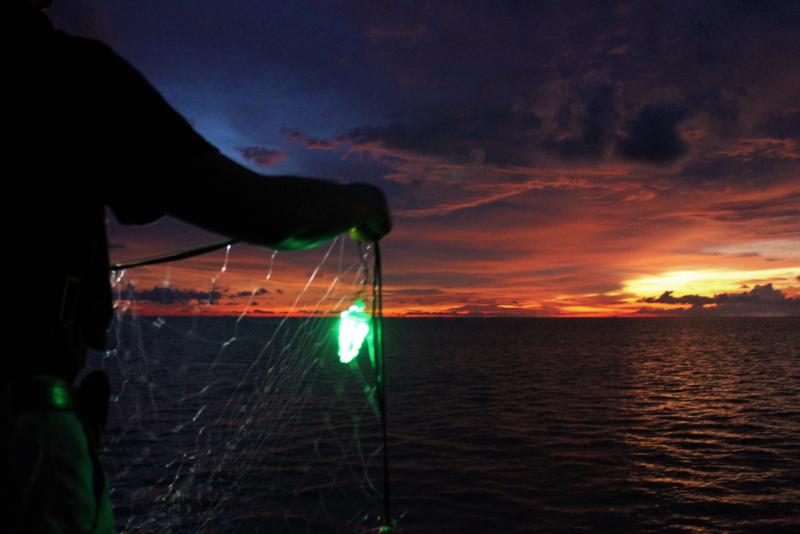Scientists are testing nets illuminated with LED lights to see if increasing net visibility reduces sea turtle bycatch in gillnet fisheries.
Gillnet fisheries operate by suspending a wall of netting in the water column. When fish and other marine animals encounter these nets, they often become entangled.

Gillnets are one of the most common types of fishing gear and are used extensively in most places where people fish for food, either commercially or for local consumption.
Unfortunately gillnets are not selective in the species that they catch. Sea turtles are one of the most common bycatch species that become entangled in these nets. Marine mammals, seabirds, and sharks are also frequently caught in gillnets across the globe.
Enter the illuminated gillnet. Studies comparing “control” or traditional nets with illuminated nets show that nets made more visible with simple LED lights can reduce bycatch of sea turtles without reducing target catch:
- Studies in Mexico show green sea turtle bycatch is reduced between 40-60% with no changes in target catch.
- Studies in Peru show green sea turtle bycatch is reduced between 65-80% with no changes in target catch.
- Studies in Indonesia show green, olive ridley and hawksbill sea turtle bycatch is reduced by 60% with increases of target catch and catch value.
In addition, recent research indicates that net illumination also reduces bycatch of other protected species such as seabirds, elasmobranchs (sharks, rays, skates, sawfish), and cetaceans (dolphins, porpoises, and whales).
A Win-Win for Fishermen and Sea Turtles
When sea turtles are caught in gillnets, they can drown and die. Extracting sea turtles and other bycatch from gillnets can result in damage to the net, which requires time and money to repair. The use of illuminated gillnets could prove beneficial for both sea turtles and fishermen by reducing sea turtle bycatch and damage to gear.
In North Carolina, inshore state gillnet fisheries are carefully managed to reduce bycatch of sea turtles. Researchers from Duke University and NOAA Fisheries are collaborating with North Carolina coastal fishermen and the North Carolina Fishermen’s Association. They are testing the effectiveness of net illumination in the coastal flounder fishery. Initial studies indicate that net illumination does not change target catch rates and may decrease the bycatch of unwanted fish species. These findings could one day provide more options for fishermen to continue fishing.
Additional Research and Next Steps

John Wang leads gillnet bycatch research at the NOAA Pacific Islands Fisheries Science Center. He and his colleagues studied sea turtle vision and tested LED lights in different wavelengths (green, orange, ultraviolet) to see if they had different effects. All of the lights reduced sea turtle bycatch at a similar rate without impacting target species catch.
Scientists are also investigating the effectiveness of sound as a deterrent. They have equipped nets with audio devices that emit an acoustic signal to alert turtles to the net and deter them. Wang said the next step is to combine the two existing approaches—lights and sound—into one gillnet experiment, to see if this combination can reduce bycatch even more.
Ultimately, Wang hopes that these gillnet bycatch reduction techniques can be used in international communities in Indonesia and the Philippines to protect the highly endangered Pacific leatherback turtle. “These turtles migrate vast distances across the Pacific, traveling from Indonesia to the U.S. Pacific Islands and back many times during their lifetime,” he explained. “If we want to protect our species and fisheries, we need to work to implement better practices worldwide.”

NOAA regularly provides technical advice and support to international partners seeking to reduce gillnet bycatch. Interest in gillnet bycatch reduction techniques is growing worldwide, and net illumination research is occurring in foreign fisheries, such as:
- Pakistan’s drift gillnet fishery.
- Italian/Slovenian/Croatian coastal gillnet fisheries in the Adriatic.
- Small-scale fisheries in Gabon.
- Coastal fisheries in Turkey.
- Ecuadorian gillnet fisheries.
Bycatch remains a major barrier to sea turtle recovery, but these promising new techniques are proving that gillnet fishery interactions may be significantly reduced with simple, relatively accessible solutions available to communities around the world.
